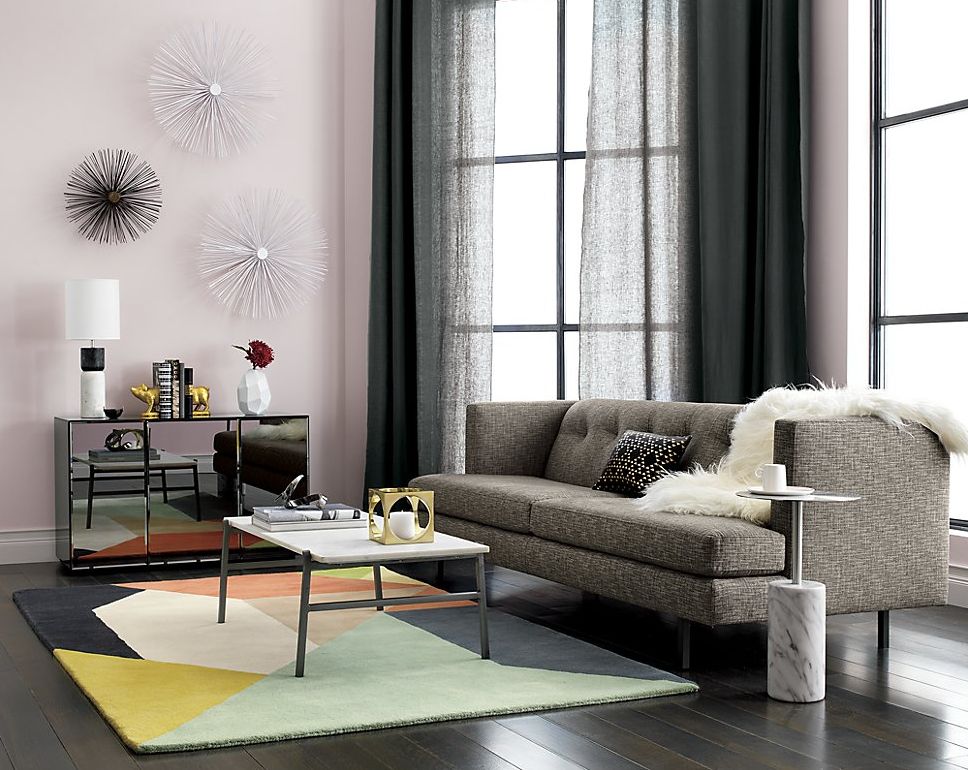Walking into a home with light hardwood floors is often an experience of airy elegance and understated sophistication. But, when it comes to choosing the perfect rug, a dilemma arises: what color will best complement the light wood, enhance the space, and create a truly inviting atmosphere? This isn’t a mere matter of personal preference; it’s a nuanced dance between color theory, room design, and the overall mood you wish to evoke.

Image: www.pinterest.com
Light hardwood floors offer a blank canvas, capable of reflecting the colors of the surrounding furniture and décor. Choosing the right rug color becomes crucial, as it can dramatically influence the room’s feel, from airy and spacious to cozy and intimate. This article delves into the intricacies of selecting the best color rug for light hardwood floors, exploring the spectrum of choices and offering practical tips for finding the perfect match.
Understanding the Color Wheel and Its Influence
The Dynamics of Light and Dark
Before delving into specific hues, it’s essential to grasp the fundamental principles of color and their impact on a room. Light colors, including shades of white, cream, and pastels, have the ability to expand a space, making it feel more spacious and airy. Conversely, darker shades, such as navy, charcoal, or deep reds, tend to contract the space, creating a sense of intimacy and coziness.
Creating Visual Balance
When dealing with light hardwood floors, the goal is to strike a balance. A rug too close in shade might blend seamlessly, negating its impact. On the other hand, a rug too contrasting could dominate the room, leaving the floors feeling out of place. The key is to find a color that both complements and enhances the light wood, adding visual interest and dimension.

Image: mromavolley.com
Navigating the Color Spectrum for Your Light Hardwood Floors
1. The Timeless Appeal of Neutrals
Neutral colors are the bedrock of interior design, offering adaptability and versatility. For light hardwood floors, neutrals can act as a unifying element, creating a calm and serene backdrop for vibrant furniture or artwork. Popular neutrals include:
- Cream: A warm and inviting choice, cream softens the light wood without overpowering it, creating a relaxed atmosphere.
- Beige: A versatile option offering a touch of warmth, beige seamlessly blends with light wood and complements a wide range of décor styles.
- Gray: A modern and sophisticated choice, gray provides a touch of coolness, grounding the lightness of the floor without feeling cold.
- White: Opting for a pure white rug can create a clean, minimalist aesthetic, especially when paired with minimalist furniture and décor.
2. Embracing the Warmth of Earthy Tones
Earthy tones, inspired by nature, bring a sense of warmth and groundedness to any space. These hues work particularly well with light hardwood floors, injecting a natural element without being too overpowering.
- Brown: A classic choice, brown complements the natural undertones of light wood, especially in warmer shades like terracotta or tan.
- Green: A refreshing and calming option, green can be used to enhance lighter wood, creating a feeling of serenity. Explore shades like sage, olive, or moss.
- Rust: A bold and dramatic choice, rust injects a touch of warmth and vibrancy into lighter wood, creating a unique and eye-catching statement.
3. Injecting Energy with Bold Hues
For those who prefer a more vibrant and expressive approach, bold colors can add personality and drama to light hardwood floors. However, it’s essential to tread carefully to avoid dominating the space.
- Blue: A calming and tranquil color, blue can be used to create a sophisticated and inviting atmosphere, especially in cooler shades like navy or indigo.
- Red: A bold and energetic choice, red can inject a sense of drama and excitement, but use it sparingly to avoid overwhelming the lighter wood.
- Magenta: A striking and eye-catching color, magenta can add a touch of whimsy and personality, especially when paired with complementary colors like green or yellow.
Beyond Color: Pattern and Texture for Added Depth
While color is crucial, pattern and texture play a crucial role in creating visual interest and enhancing the overall ambiance. For light hardwood floors, consider the following:
- Geometric Patterns: Adding a geometric pattern rug can create a bold statement, especially when paired with simpler furnishings and décor.
- Floral Motifs: For a touch of romanticism and elegance, choose a rug with a delicate floral pattern, adding a touch of softness to the space.
- Textured Fabrics: Rugs made from materials like wool, jute, or sisal offer a tactile experience and add visual depth, especially when combined with a contrasting color.
Choosing the Right Rug Size and Placement
The size and placement of your rug are as crucial as its color. Too small, and it can feel insignificant; too large, and it can overwhelm the room. General guidelines include:
- Living Rooms: The rug should extend out from under the front legs of the seating furniture, creating a cohesive seating area.
- Dining Rooms: The rug should be large enough to accommodate all the chairs when they are pulled out for dining, leaving at least 18 inches of space between the edge of the rug and the wall.
- Bedrooms: The rug should extend at least 2 feet beyond the sides of the bed, creating a comfortable and welcoming space.
Best Color Rug For Light Hardwood Floor
Conclusion: Finding Your Perfect Rug Match
Choosing the best color rug for light hardwood floors is a rewarding endeavor, adding character and personality to your space. By exploring the color wheel, understanding the interplay of light and dark, and considering your desired mood and style, you can make informed choices that enhance the beauty and functionality of your home. Remember, the perfect rug is not merely an aesthetic addition; it’s a reflection of your unique taste and a testament to the transformative power of color and design.





